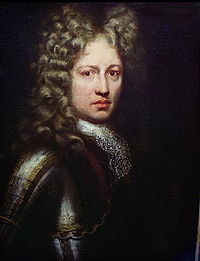
Earl of Lucan is a title which has been created twice in the Peerage of Ireland for related families.

Patrick Sarsfield, 1st Earl of Lucan was an Irish soldier and Jacobite. Killed at Landen in 1693 while serving in the French army, he is now best remembered as an Irish patriot and military hero.

The Treaty of Limerick, signed on 3 October 1691, ended the 1689 to 1691 Williamite War in Ireland, a conflict related to the 1688 to 1697 Nine Years' War. It consisted of two separate agreements, one with military terms of surrender, signed by commanders of a French expeditionary force and Irish Jacobites loyal to the exiled James II. Baron de Ginkell, leader of government forces in Ireland, signed on behalf of William III and his wife Mary II. It allowed Jacobite units to be transported to France, the diaspora known as the Flight of the Wild Geese.

Sir Phelim Roe O'Neill of Kinard was an Irish politician and soldier who started the Irish rebellion in Ulster on 23 October 1641. He joined the Irish Catholic Confederation in 1642 and fought in the Wars of the Three Kingdoms under his cousin, Owen Roe O'Neill, in the Confederate Ulster Army. After the Cromwellian conquest of Ireland O’Neill went into hiding but was captured, tried and executed in 1653.
Sir Rory O'Moore, also known Sir Roger O'Moore or O'More or Sir Roger Moore, was an Irish landowner, and is most notable for being one of the four principal organisers of the Irish Rebellion of 1641.

Colonel Henry Luttrell was an Irish soldier known for his service in the Jacobite cause. A career soldier, Luttrell served James II in England until his overthrow in 1688. In Ireland he continued to fight for James, reaching the rank of General in the Irish Army.
Events from the year 1689 in Ireland.
Turnings is a townland and historic site in County Kildare, Ireland, situated on the banks of the Morell River, a tributary of the River Liffey 25 km upstream from the Irish capital Dublin. It is a rural area, and a planning application has been lodged with Kildare County Council (2007) to develop a town in the district.

Sir Theophilus Jones, was an Irish soldier and government official of Welsh descent. One of five sons born to Lewis Jones, Bishop of Killaloe in the Church of Ireland, he formed part of a close-knit and powerful Protestant family.
Oliver O'Gara was an Irish politician and soldier of the 17th and 18th centuries who was closely identified with the Jacobite cause.
Sir William Sarsfield was an Irish landowner, public official and soldier of the sixteenth century.
Peter Sarsfield was an Irish landowner of the seventeenth century.
Terence O'Dempsey, 1st Viscount Clanmalier was an Irish aristocrat.

Lucan Manor is a Georgian-Palladian house and estate in Lucan, County Dublin. A manor house, it is remembered particularly for its association with the Sarsfield family. A castle or house has been recorded on the site since at least the 12th century.

Honora Burke became Honora FitzJames, Duchess of Berwick on Tweed, married Patrick Sarsfield and went into French exile where he followed her soon afterwards. After his death at the Battle of Landen, she married James FitzJames, 1st Duke of Berwick, an illegitimate son of James II. She may have introduced the country dance to the French court.
Ulick Burke, 1st Viscount Galway was an Irish army officer slain at the Battle of Aughrim while fighting for the Jacobites during the Williamite War in Ireland.
The Capture of Bandon occurred in 1689 when the town of Bandon in County Cork, Ireland was forcibly seized from its rebellious Protestant inhabitants by force of Irish Army troops under Justin McCarthy. The skirmishing at the town took place during the early stages of the Williamite War in Ireland. The Jacobite success at Bandon helped suppress any chance of a general Munster uprising against the rule of James II similar to that which occurred in Ulster the same year. The slogan "No Surrender!" is believed to have been first used at Bandon and subsequently taken up, more famously, by the defenders at the Siege of Derry the same year.
William Sarsfield was an Irish landowner of the seventeenth century. He was the elder brother of the Jacobite soldier Patrick Sarsfield.
Francis Sarsfield was an Irish lawyer and landowner of the seventeenth century.
James Sarsfield, 2nd Earl of Lucan (1693-1719), was a French-born Jacobite of Irish descent.









